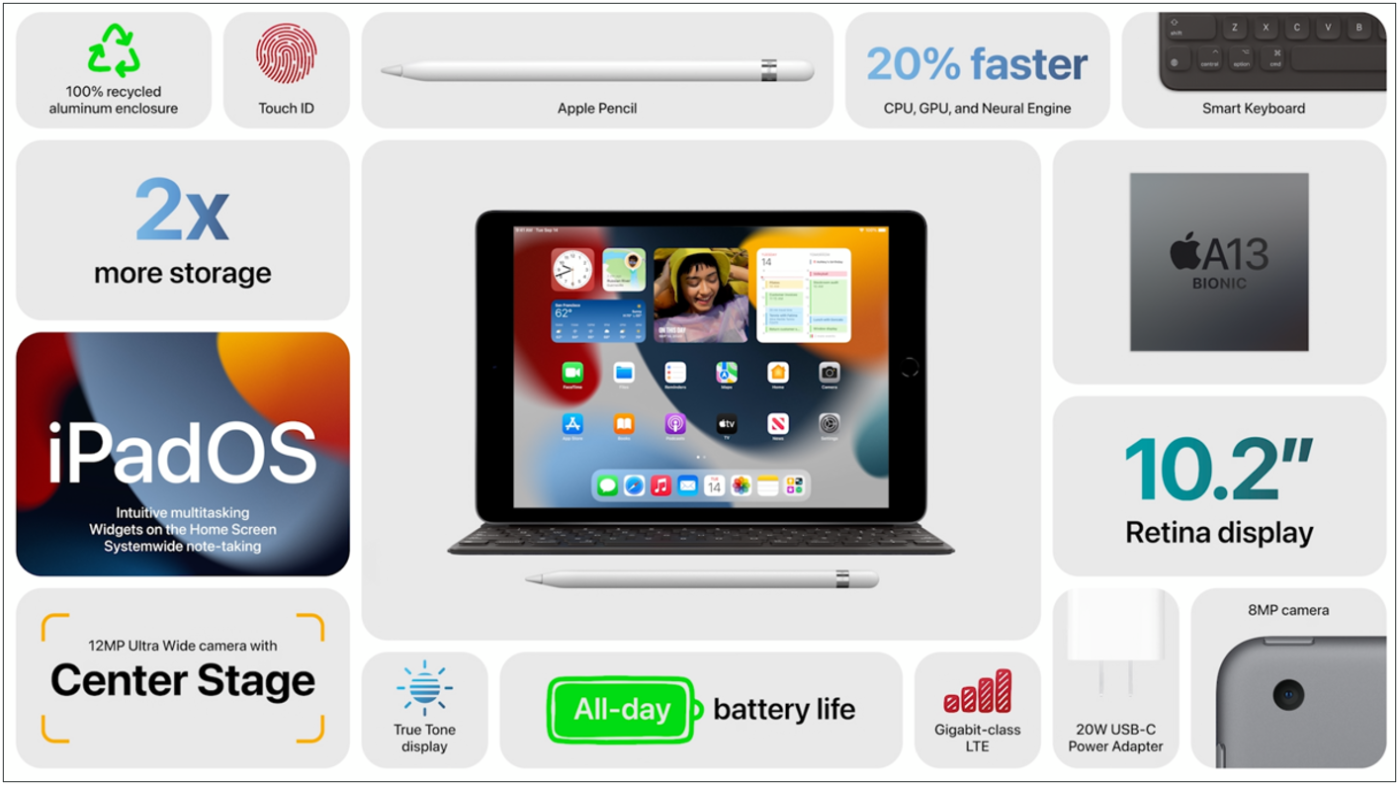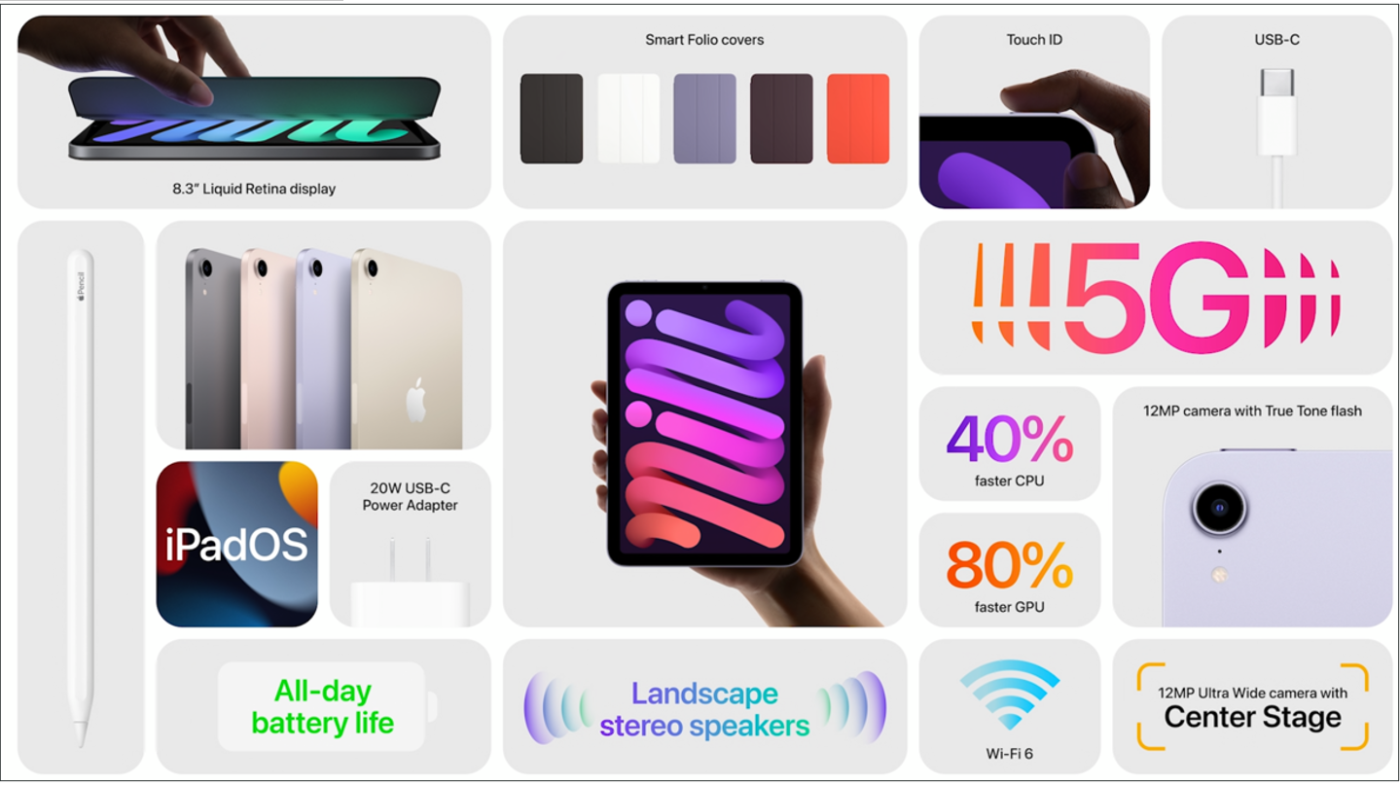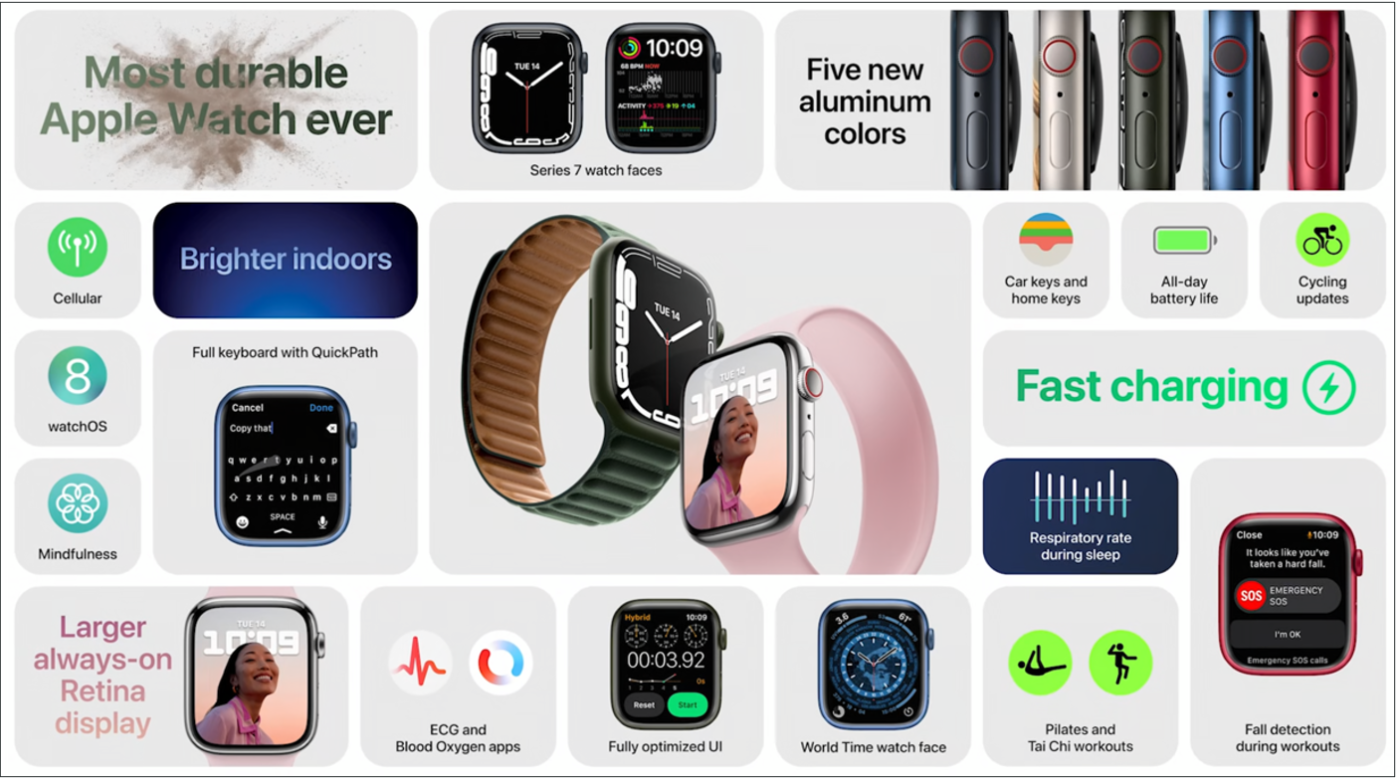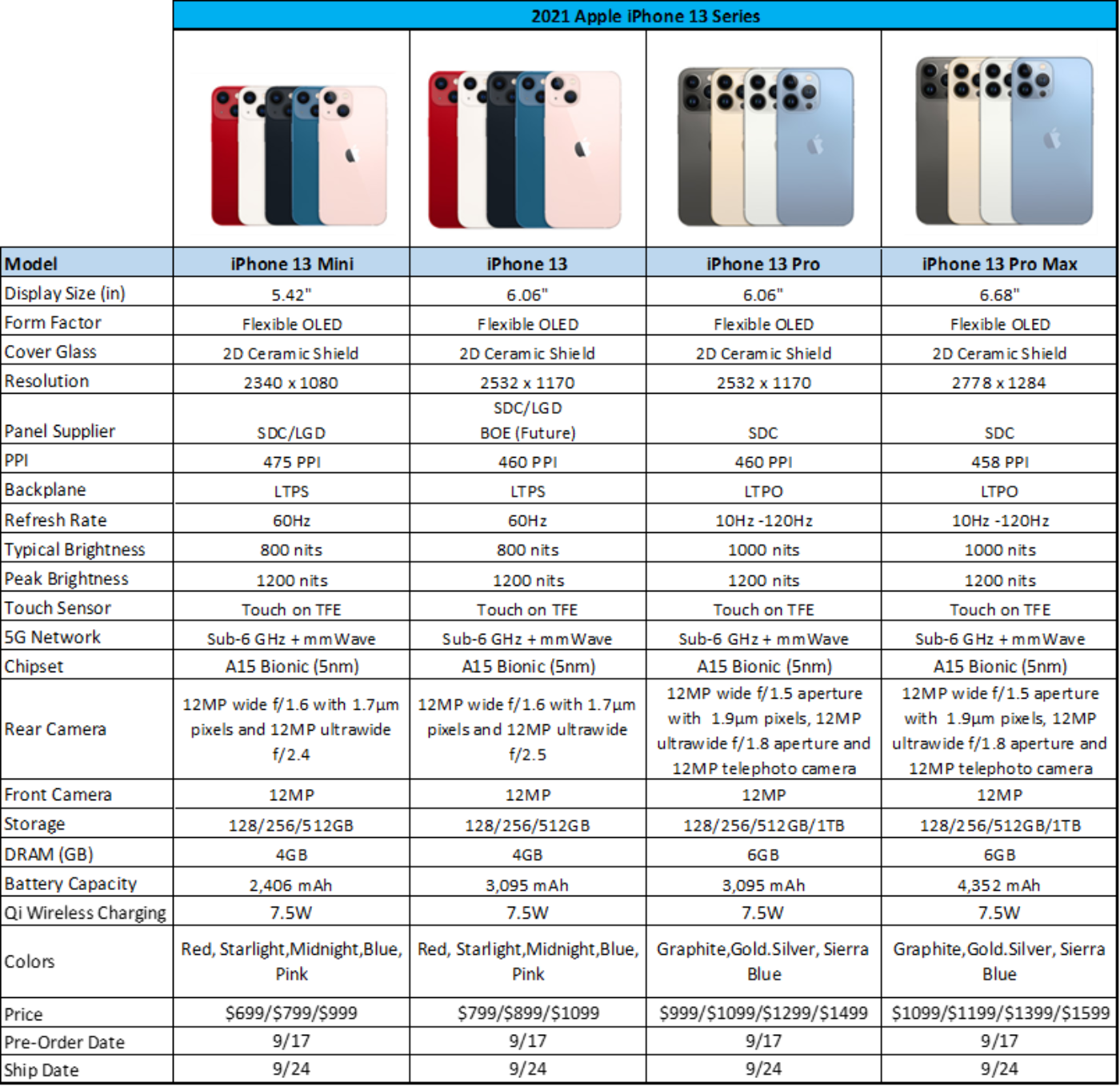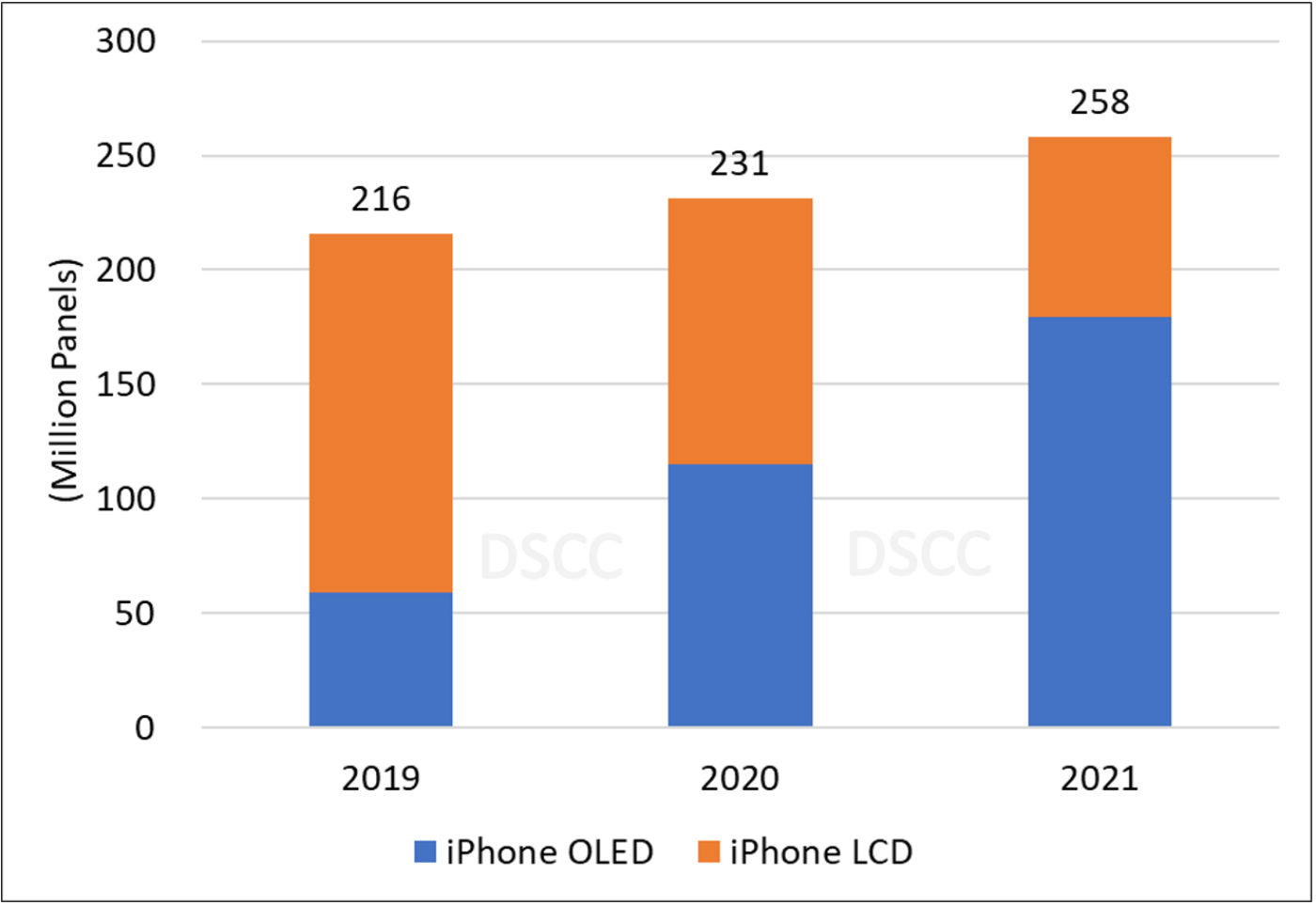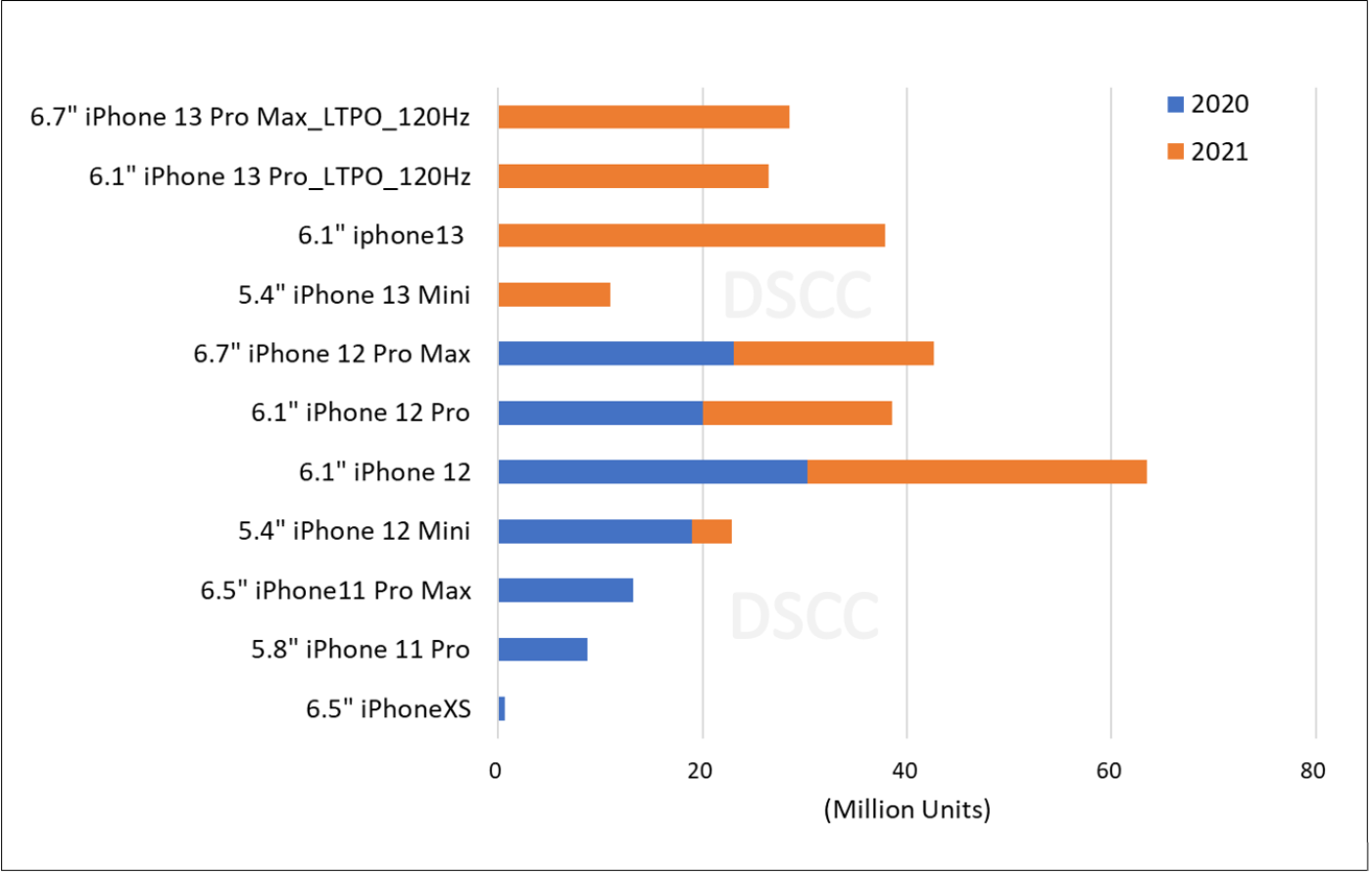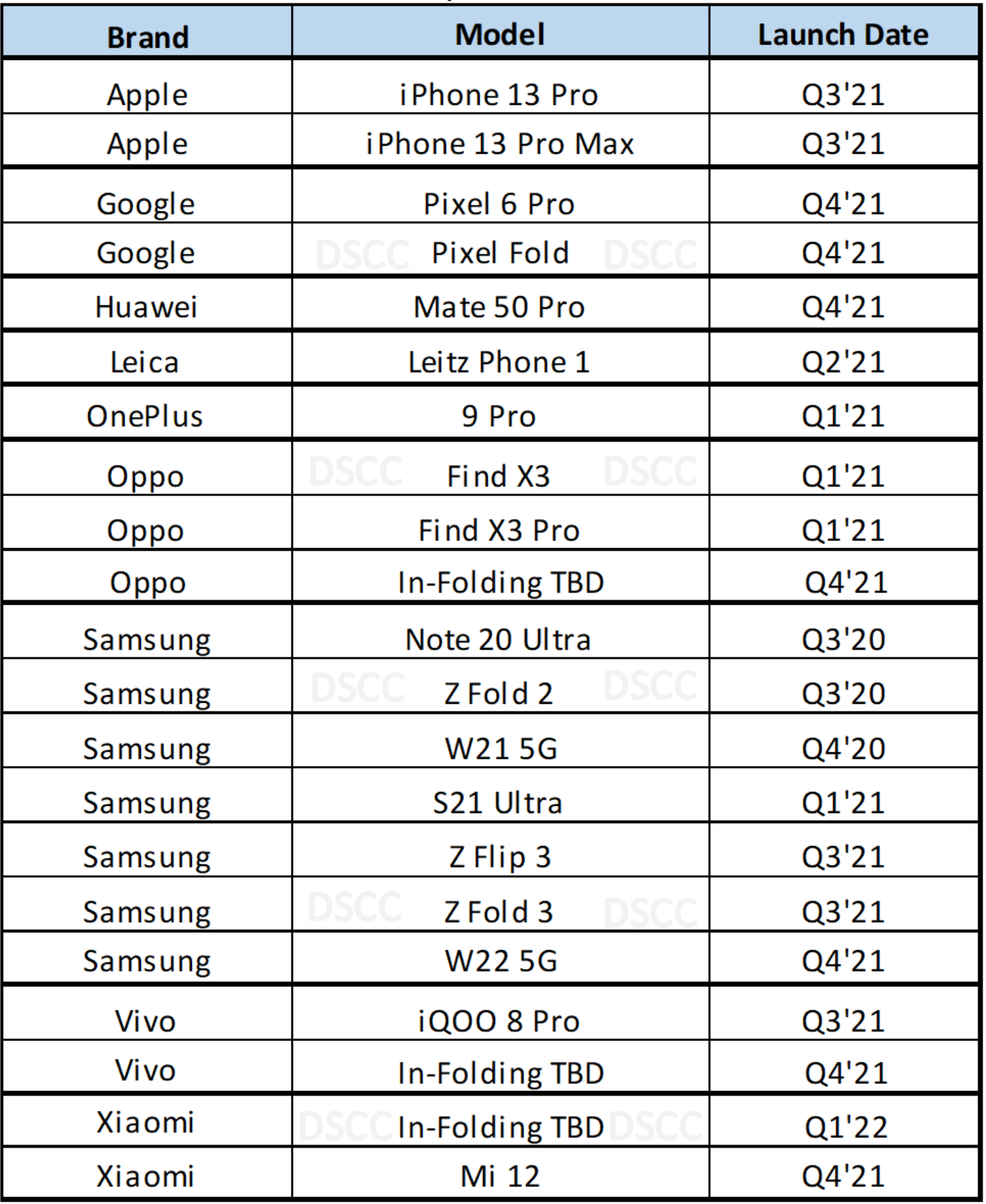国内お問い合わせ窓口
info@displaysupplychain.co.jp
FOR IMMEDIATE RELEASE: 09/20/2021
Apple Announces New Products Including the iPhone 13 Series with Higher Refresh Rates, Bigger Batteries, More Storage and Better Cameras
David Naranjo, Senior DirectorSan Diego, CA USA -
Apple announced several new products during their California Streaming event on Tuesday, September 14th. Apple announced a new iPad, iPad Mini, Apple Watch Series 7 and four new models of the iPhone 13 series. Let’s start with the iPad and iPad Mini.
The iPad uses a 10.2” IPS LED display and uses the 7nm A13 Bionic chip (2020’s iPad used the 7nm A12 Bionic chip). Apple noted that the A13 Bionic chip brings a 20% speed improvement to the CPU, GPU and neural engine and is 3x faster than the top selling Chromebook and 6x faster than the top selling Android tablet. I have not seen actual test results and comparable products but will report on this claim when results become available. The iPad also has a 12MP ultrawide front camera with 122-degree field of view (similar to the front camera on iPad Pro). The feature named Center Stage that is in iPad Pro is now in the new iPad. The iPad starts at $329, with 64GB storage and for the education segment, the price starts at $299. A Wi-Fi + 5G option is also available that starts at $459.
The iPad Mini uses an 8.3” IPS LED display and uses the 5nm A15 Bionic chip (2020’s iPad Mini 5 used the A12 Bionic chip). Apple noted that the A13 Bionic chip brings a speed improvement of 40% to the CPU and an 80% speed improvement to the GPU. The iPad Mini now has a USB-C port and has a 12MP rear camera with a larger aperture of f/1.8, the front camera is upgraded to 12MP (the iPad Mini 5 had an 8MP front camera). The feature named Center Stage, which was introduced last year on the iPad Pro, is now available on the iPad Mini. The iPad Mini starts at $499 with 64GB storage. A Wi-Fi + 5G option is also available that starts at $649.
iPad Feature Summary
iPad Mini Feature Summary
Now for the Apple Watch Series 7. The Apple Watch Series 7 uses a 1.6” (41mm) and 1.78” (45mm) LTPO OLED display. The 1.78” OLED display is supplied by JDI and the 1.6” OLED display is supplied by LGD. The bezels on the Series 7 have been reduced to 1.7mm, which enables 20% more screen area versus Series 6. The Watch Series 7 starts at $399 and is available later this fall. In addition to the specifications, Apple spent time on the Fitness + app which is currently available in six countries and will expand to 18 countries later this year.
Apple Watch Series 7 Feature Summary
The iPhone 13 series was introduced next and the specifications that DSCC and others have predicted have been confirmed. The iPhone 13 series has four models as listed in our table in this article, the iPhone 13 Mini, iPhone 13, iPhone 13 Pro and iPhone 13 Pro Max. The iPhone 13 Mini uses a 5.42” flexible OLED display supplied by SDC and LGD. The iPhone 13 uses a 6.06” flexible OLED display supplied by SDC, LGD and in the future by BOE. As reported by TheElec, BOE recently received conditional approval from Apple to supply OLED panels for the iPhone 13. The iPhone 13 and iPhone 13 Mini have a 60Hz refresh rate, have a smaller notch (20% smaller than iPhone 12), 20% brighter display, starts with 128GB storage (the iPhone 12 and iPhone 12 Mini starts at 64GB storage), uses the 5nm A15 Bionic Chip and will have the new iOS15. Although the battery capacity specifications were not mentioned, it was noted during the event that iPhone 13 Mini users will see an average increase of 1.5 hours per day versus the iPhone 12 Mini and an average increase of 2.5 hours per day on the iPhone 13 versus the iPhone 12. The iPhone 12 Mini and iPhone 12 have battery capacities of 2,227mAh and 2,815mAh, respectively. Our specification table notes that the iPhone 13 Mini and iPhone 13 have battery capacities of 2,406mAh and 3,095mAh, respectively.
The camera improvements were the big highlight for the upgrades of the iPhone 13 and iPhone 13 Mini. The iPhone 13 uses a dual rear camera system with a 12MP wide camera with f/1.6 aperture using new 1.7μm pixels and a 12MP camera, with f/2.4 aperture that includes optical image stabilization similar to the iPhone 12 Pro. The front camera is a 12MP camera with f/2.2 aperture. For video, iPhone 13 and iPhone 13 Mini now have a mode called Cinematic mode. The cinematic mode (also called rack focus by film directors) is the technique used by film directors to dynamically focus the images on screen. If you have seen films where the primary subject is in focus while either the foreground or background looks blurry, you have seen this technique called rack focus.
The iPhone 13 Mini starts at $699 and iPhone 13 starts at $799, with 128GB storage. These phones can be preordered as of September 17th, with shipments starting on September 24th. Apple and US carriers (AT&T, Verizon, T-Mobile) offer up to a $700 discount for a qualifying iPhone trade-in. We have seen promotions from T-Mobile that go as high as $1000. Apple also mentioned doubling the number of 5G carrier partners to 200 carriers in over 60 countries and regions.
There was a rumor regarding satellite coverage, which I dispelled in the September 6th edition in of DSCC Weekly. The iPhone 13 series uses the Qualcomm X60 modem chip, which has no support for satellite or additional terrestrial bands. The antenna used on the iPhone 13 series are designed by Apple.
The iPhone 13 Pro and iPhone 13 Pro Max had significant display upgrades versus iPhone 12 Pro and iPhone 12 Pro Max. The OLED displays on the iPhone 13 Pro and iPhone 13 Pro Max are 6.06” and 6.68” LTPO OLED displays supplied the SDC. The iPhone 12 Pro and iPhone 12 Pro Max used identical screen sizes but were LTPS OLED displays. SDC is currently the only panel supplier of LTPO OLED displays. Although other brands like Oppo have smartphones that have 1Hz – 120Hz variable refresh rates, the iPhone 13 Pro and iPhone 13 Pro Max have a variable refresh rate of 10Hz – 120Hz. Apple calls this feature ProMotion. We believe that Apple chose to only go as low as 10Hz to avoid possible flicker issues, although this is not confirmed.
The iPhone 13 Pro and iPhone 13 Pro Max models use the 5nm A15 Bionic Chip, iOS15, and have a triple rear camera configuration. The rear cameras include a 12MP ultrawide camera with f/2.4 aperture, a 12MP wide camera with 1.9μm pixels and f/1.6 aperture, which Apple claims provides 47% more light gathering and a 12MP telephone camera with 3x optical zoom. The front camera is a 12MP camera with a f/2.2 aperture. Apple mentioned that the A15 Bionic chip and the new 5 core GPU provides up to 50% faster graphics versus the competition. For the iPhone 13 Pro, Apple mentioned that users will see an average increase of 1.5 hours per day versus the iPhone 12 Pro and for the iPhone 13 Pro Max, an increase of 2.5 hours per day versus iPhone 12 Pro Max. The iPhone 12 Pro and iPhone 12 Pro Max have battery capacities of 2,815 mAh and 3,687 mAh, respectively. The following table notes that the iPhone 13 Pro and iPhone Pro Max have battery capacities of 3,095 mAh and 4,352 mAh, respectively. Apple has also increased the selectable storage options for the iPhone 13 Pro and iPhone 13 Pro Max to 1TB.
The iPhone Pro starts at $999 and the iPhone 13 Pro Max starts at $1099 with 128GB storage. These phones can be preordered as of September 17th, with shipments starting on September 24th. Apple and US carriers (AT&T, Verizon, T-Mobile) are offering up to a $1000 discount for a qualifying iPhone trade in.
For 2021, DSCC is forecasting by panel procurement 258M units of total (LCD + OLED) panels for 2021 and 179M units of OLED panels for iPhone products.
By OLED panel procurement for 2021, we expect the iPhone 13 Mini to account for 6% share, iPhone 13 to account for 21% share, iPhone Pro to account for 15% share and the iPhone Pro Max to account for 16% of OLED panels procured in 2021 by Apple.
Apple iPhone Total Panel Procurement, 2019-2021
Apple iPhone OLED Panel Procurement, 2020-2021
Apple’s introduction of the iPhone 13 Pro and iPhone 13 Pro Max using LTPO OLED panels from SDC adds to the total of 21 flexible and foldable OLED smartphones that are current and rumored for 2020-2021 and Q1’22. At DSCC, we track smartphone OLED shipments by brand, panel supplier and key features in the Quarterly Advanced Smartphone Features Report (一部実データ付きサンプルをお送りします) and Quarterly Foldable/Rollable Display Shipment and Technology Report (一部実データ付きサンプルをお送りします) The following table highlights the brand and model of LTPO smartphones that are current and rumored for 2021.
Current and Rumored LTPO OLED Smartphones
About Counterpoint
https://www.displaysupplychain.co.jp/about
[一般のお客様:本記事の出典調査レポートのお引き合い]
上記「国内お問い合わせ窓口」にて承ります。会社名・部署名・お名前、および対象レポート名またはブログタイトルをお書き添えの上、メール送信をお願い申し上げます。和文概要資料、商品サンプル、国内販売価格を返信させていただきます。
[報道関係者様:本記事の日本語解説&データ入手のご要望]
上記「国内お問い合わせ窓口」にて承ります。媒体名・お名前・ご要望内容、および必要回答日時をお書き添えの上、メール送信をお願い申し上げます。記者様の締切時刻までに、国内アナリストが最大限・迅速にサポートさせていただきます。
